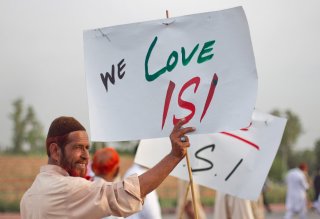Pakistan’s ISI Has Become the Model for Iranian Intelligence
The ISI has condemned Pakistan to a morass. At a time when Iranians may hope to emerge from theirs, it would be tragic if a failed, selfish model undercuts their ability to do so.
The Taliban’s victory in Afghanistan renewed focus on Pakistan’s Inter-Services Intelligence (ISI) agency. The ISI did not create the Taliban, but they co-opted them and, since 1994, have used them as a tool of Pakistani policy. Pakistan’s ISI chiefs have been unapologetic about their relations with the Taliban and their role in the movement’s victory over the United States and its Afghan allies.
The ISI, however, is not just about the Taliban. Pakistan created the ISI 1948 in the aftermath of the fighting that accompanied India’s partition the previous year. India’s relative military success in the fighting over areas like Kashmir, which is disputed territory, convinced Pakistan that it needed both better intelligence and an effective means to coordinate among its army, air force, and navy.
While the ISI had significant influence over the military and the Pakistani military itself rose in domestic influence after General Ayub Khan overthrew the civilian government in 1958, the ISI propelled itself further into the political and governmental sphere after Pakistan’s loss of Bangladesh in 1971. The loss of half of Pakistan shocked the country but, rather than acknowledge the real reasons—Punjabi arrogance and decades of West Pakistan’s neglect of East Pakistan—the ISI instead blamed India for fomenting ethnic unrest and demanded greater control over Pakistan’s civilian sphere.
The Soviet invasion of Afghanistan eight years after the loss of Bangladesh was a dream come true for the ISI. While Pakistani authorities certainly feared Soviet designs, the Soviet presence in Afghanistan made Pakistan crucial to anti-Soviet resistance. Afghanistan was landlocked, the Central Asian states were part of the Soviet Union, and Iranian revolutionaries had, just weeks before, seized the U.S. Embassy in Tehran. The ISI was firm: All money and weaponry would pass through it; should a few billion dollars go missing here and there, that was simply the cost of doing business. Such money did not just go into the generals’ villas or offshore accounts, however; rather, the ISI diverted much of it to fund their own special domestic projects.
In the years since Bangladeshi independence and the Soviet invasion of Afghanistan, ISI dominance of Pakistan has grown. The United States and NATO’s post-9/11 involvement in Afghanistan allowed the ISI to be the arsonist while it collected the firefighter’s salary. While, in theory, the prime minister appoints the ISI director, in recent years the reality appears opposite: No civilian prime minister can serve without subordinating himself to the whims of the ISI.
For Pakistan, the ISI cancer has been poison. While the ISI is convinced it can control and channel the forces it shaped, tens of thousands of Pakistanis have already died for the intelligence agency’s mistakes. For Iran’s own intelligence service, some Iranians tell me, the ISI has become a source of emulation.
Iran is nearing an inflection point. Supreme Leader Ali Khamenei is eighty-two-years-old; many of his revolutionary contemporaries have already passed away. Many analysts, myself included, saw Ebrahim Raisi’s rise to the presidency in the context of positioning to succeed Khamenei. But the path to succession may not be cut-and-dry. The supreme leadership could be collective if there is no consensus around Raisi’s accession. The Islamic Revolutionary Guard Corps (IRGC) could also block a smooth succession—or eviscerate its substance—if it fears that any new leader could threaten its economic interests.
Within the Iranian system, however, there are different power centers, many of which compete with each other. The Ministry of Information and Security (MOIS or, by its Persian acronym VeVAK), the Islamic Republic’s intelligence ministry, often competes with the IRGC in both internal security functions and sometimes external operations as well. In recent years, the balance and tension between the two was evident in the transition between President Mahmoud Ahmadinejad and President Hassan Rouhani. Ahmadinejad was the first president to emerge from IRGC circles. He empowered many IRGC veterans in order to flush the system of those whom his predecessor, Mohammad Khatami, had put in place. Within just a few years, the growth of internal IRGC influence worried Khamenei, though, as it posed a direct threat to the clergy. Accordingly, Rouhani—who had always served as the regime’s “Mr. Fix-It” in times of crisis—replaced IRGC veterans not with reformers or moderates as some in American and European progressive circles imagined, but rather with MOIS veterans.
Today, the MOIS has had a taste of power and the perks of office and, like the IRGC before them, do not want to forfeit such privileges. As Khamenei’s rule enters its twilight, they look to Pakistan’s ISI as a model for their own future: They seek to operate largely in the shadows, but monopolize internal security decision-making and maintain a veto over Iran’s future political leadership.
Iranians would be the first to admit that the MOIS is not as organized as Pakistan’s ISI, but the ambition is there. The Iranian regime is entering a period of both weakness and transition, not unlike the upheaval that Pakistan experienced in 1971. The question for Iranians now is whether the MOIS will be able to fulfill its ambition in any vacuum or if Iranians will be vigilant enough to sidetrack its goals. Certainly, a more proactive, less solicitous American policy would aim to undercut and undermine not only prominent IRGC generals, but MOIS ambitions as well.
The ISI has condemned Pakistan to a morass. At a time when Iranians may hope to emerge from theirs, it would be tragic if a failed, selfish model undercuts their ability to do so.
Michael Rubin is a senior fellow at the American Enterprise Institute.
Image: Reuters.

